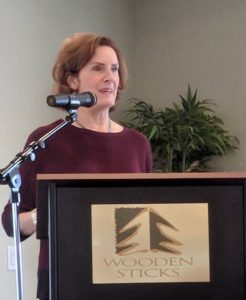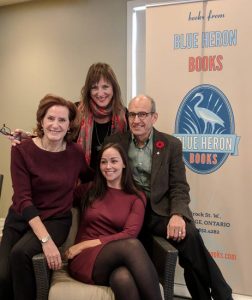
Last Sunday morning, I watched a seasoned journalist get uncharacteristically emotional. Previously a foreign correspondent, a reporter who’d covered hostilities in the Middle East and a long-time current affairs radio host, Carol Off’s eyes welled up. She recalled, in 2002, convincing Asad Aryubwal, an Afghan father of five, to go on-camera to expose the warlords the U.S. military was courting to overthrow the Taliban.
“Asad’s courage in speaking out was rewarded only with the calamity when, in response to (my) documentary,” Off told Zoomer magazine, “Afghanistan’s most powerful warlord sent a death squad to kill him.”
Carol Off, for the past dozen years the host of CBC Radio’s “As It Happens,” was my guest at the Blue Heron’s most recent Books and Brunch. I’d asked her why she decided to break the code of journalism not to get involved with one’s sources. She explained, in this case, that she could not maintain a journalist’s distance. She couldn’t be disinterested in the life of her source.
“I was the one who had got (the Aryubwal family) into this trouble,” she said, “and I decided that it was my job to get them out of it.”
Then began an eight-year journey battling bureaucracies, overcoming barriers by politicians, diplomats and civil servants, and the inertia of xenophobia that blocked Off’s attempts to bring an upstanding Afghan citizen and his family out of the ruins of his homeland to a new life in Canada. And as I sat watching a journalist who sensed a greater commitment to humanity than higher ratings, I realized how some of the decisions we make in the media influence and sometimes change people’s lives.
Often that reality – the fact that the stories we choose and the way we choose to publish them – is overlooked, or at least cast aside, in lieu of getting a better piece of video on the screen, a more dramatic headline atop a front page, or a more tearful conversation on our soundtrack.
I have a vivid memory of one such media decision I made that had unexpected consequences. Do you remember the story of Rev. Jim Jones? He was the American preacher who brainwashed almost a thousand followers, mostly young people, and led them from California to a settlement in the jungles of Guyana in South America. His so-called People’s Temple preyed on the wealth of his followers to finance the enterprise and demanded total commitment to Jones.
Then, in 1978, when U.S. Congressional investigators closed in on him, Rev. Jones convinced more than 900 of his faithful to “save themselves” by drinking cyanide-laced fruit drink; they died within five minutes in the largest single loss of American life (before 9/11).
At the time, as the producer of a morning current affairs radio program, I came across the story of a woman who practised reverse-brainwashing in San Francisco. When American parents began losing their children to these religious cults, some of them hired professionals to kidnap their children back, bring them to safe houses and have their religious fanaticism reversed by a professional psychiatrist. I managed to track down this woman’s phone number and called.
“Who is this?” I heard on the other end of the line. “This is the San Francisco Police Department. Identify yourself.”
The SFPD had tapped her phone and was intercepting all calls to the safe house. I explained who I was, that I wanted to interview the reverse-brainwashing specialist, and agreed to maintain her anonymity if and when we got the interview. Several days later, the safe house called back. I had been cleared by the police. I submitted my questions and we conducted a pre-recorded interview.
“Why did I have to go through the police to get this interview?” I asked.
“Because we receive death threats from these cults all the time,” she said.
I don’t think I ever considered my every question in an interview as thoroughly or as carefully as I did in that hour-long conversation. But she answered every question, exposed the perversity of the cults and gave us extraordinary audio tape for our broadcast. I edited it and put it on air the next day. The interview and the story provoked perhaps the greatest listener response I’d ever known. I was stunned by its impact. But that couldn’t compare with the aftermath. A week later, we learned that the woman had been shot and killed in San Francisco in a contract killing. I was nearly physically sick at the news and contacted the safe house again with condolences.

“She fully expected this to happen,” the safe house people told me. “But she decided it was a calculated risk.”
This all came back to me as I watched Carol Off overcome by the emotion of her decision not to keep her distance and to help Asad Aryubwal’s family get out of Afghanistan. And as I weighed my own experience, I put any thought of criticism aside. Carol’s decision to place human life above journalistic codes proved more difficult, but more appropriate. It was the right thing to do.